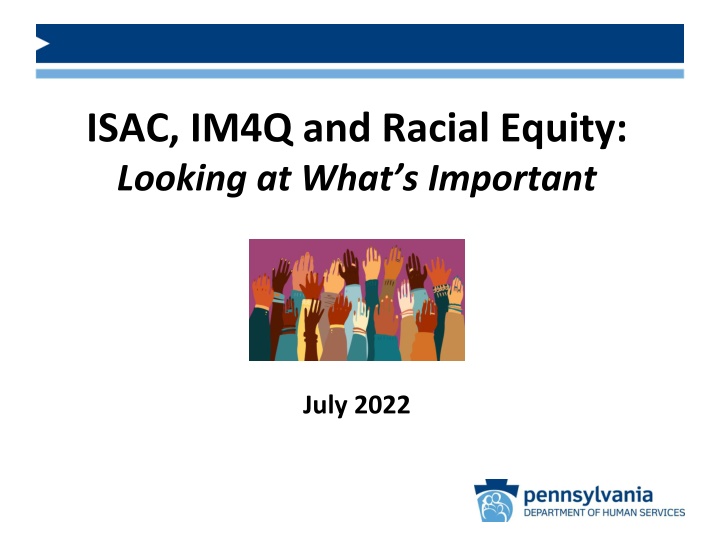
ISAC, IM4Q, and Racial Equity in Service Delivery Recommendations
Explore the essential recommendations and strategies from ISAC related to IM4Q and racial equity. Understand the importance of promoting racial diversity and inclusion in service delivery for a more just and stronger community. Learn how to improve quality through person-centered outcomes and address racial disparities effectively.
Download Presentation

Please find below an Image/Link to download the presentation.
The content on the website is provided AS IS for your information and personal use only. It may not be sold, licensed, or shared on other websites without obtaining consent from the author. If you encounter any issues during the download, it is possible that the publisher has removed the file from their server.
You are allowed to download the files provided on this website for personal or commercial use, subject to the condition that they are used lawfully. All files are the property of their respective owners.
The content on the website is provided AS IS for your information and personal use only. It may not be sold, licensed, or shared on other websites without obtaining consent from the author.
E N D
Presentation Transcript
ISAC, IM4Q and Racial Equity: Looking at What s Important July 2022
ISAC: ODPs Quality Council Information Sharing & Advisory Committee (ISAC) 2
ISAC Recommendation #9 Improve Quality Together we must plan and deliver services and supports that adhere to our values, measure person-centered outcomes, and continuously improve an individual s quality of life. All stakeholders must be engaged in the process of measuring how well services assist people in achieving an everyday life. 3/18/2025 3
ISAC Performance Measures & Updates Based on feedback from ISAC during annual report review Continued work to improve tools used to see how AEs, SCOs and Providers are doing One main objective - shift some things we measure from "compliance focused" to "person-centered outcomes focused" (direct impact on people we serve) Many ISAC performance measures are informed by IM4Q. 3/18/2025
ISAC Recommendation 14: Promote Racial Equity Communities are richer, more just, and stronger when we honor and respect the whole of racial diversity. Access to a quality, person- centered, culturally competent system of supports and funding must be equally available regardless of race. Services must include planning over a life span and address racial disparities, including disparate outcomes. The duty to ensure that racial diversity is promoted and supported, at all levels within the services system, must be embraced.
Develop Strategies The Racial Equity Subcommittee developed strategies for the new recommendation: 1. Consistently include breakdowns by race in data analysis and reporting and incorporate in QM plans. 2. Provide organizations with ways/framework to evaluate their own racial performance. 3. Support organizations with tools to improve racial equity performance and ensure increasing levels of racial diversity and inclusion, across all levels of the organization, as part of their quality management strategy.
Strategy #1 Consistently include breakdowns by race in data analysis and reporting and incorporate in QM plans.
Racial Equity Data Collection Activities Embed racial equity data collection and analysis: ISAC recommendation performance measured by IM4Q (Section 1) IM4Q performance indicators and Racial Equity (Section 2)
ISAC #1: Assure Effective Communication For people who do not communicate effectively using words, the percent of people with a communication system in place, overall and by race, age, and living situation, i.e., a written plan in place that describes and documents a communication system, e.g., sign language, a picture board/system such as Picture Exchange Communication System (PECS), a voice-output communication device, or a combination of methods. A communication profile in the ISP is not sufficient in and of itself. (IM4Q) For people with communication systems in place, the percent of individuals and self-advocates, overall and by race, who report using them across all settings (i.e., you use the system at home, at work, at school, and in your community). (IM4Q)
ISAC #2 & 4: Promote Self-Direction & Support Families 2. Promote Self-Direction, Choice & Control Percent of individuals who reported they vote, overall and by race. (IM4Q) Percent of individuals who said they were given a choice to live where people without disabilities live, overall and by race. (IM4Q) 4. Support Families Throughout the Lifespan Percent of relatives, overall and by race, who reported the Supports Coordinator asks about their vision for an everyday life for their family member. (IM4Q)
ISAC #5 & 10: Promote Health & Community Living 5. Promote Health, Wellness and Safety When asked how hard it is to get dental services in their community, percent of individuals, overall and by race, who reported it was very easy or easy, in-between, or very hard or hard. (IM4Q) 10. Expand Options for Community Living Percent of people who like where they live, overall and by race. (IM4Q)
ISAC #11: Increase Community Participation 11: Increase Community Participation Percent of respondents who say their relative has enough opportunities to participate in activities outside of where they live. (IM4Q) Percent of respondents who say their relative has the opportunity to learn new things. (IM4Q)
SECTION 2: IM4Q PERFORMANCE INDICATORS Exploring use of data through establishing racial indicators from IM4Q
IM4Q: Adding Racial Indicators to Existing Scales Racial data indicators could be organized and included in these existing 7 scales (0 - 100) currently used in the IM4Q Annual Report. 1. SATISFACTION 2. DIGNITY 3. CHOICE 4. INCLUSION 5. PHYSICAL SETTING 6. FAMILY SATISFACTION 7. AFRAID
IM4Q Scales: Satisfaction & Dignity 1. SATISFACTION 2. DIGNITY Higher score = Higher level of satisfaction Higher score = Staff and housemates treat them nicer SATISFACTION Questions (6) Like where you live Live somewhere else Like work/activities Do something else Lonely Happy/sad DIGNITY Questions (3) Work/activity staff nice or mean Home staff nice or mean Housemates nice or mean
Satisfaction scale a s ac on cale y ace Satisfaction Scale By Race (N=2,250) . . . 89.2% . . 86.7% . 85.5% . 83.1% . . . 78.5% . . . . . . Asian Black White Mi ed Mixed t er Other sian lack ite 3/18/2025
IM4Q Scales: Choice & Inclusion 3. CHOICE 4. INCLUSION Higher score means that individual has more choice and control. Higher score means that individual has more frequent community participation. Inclusion Questions (7) Choice Questions (10) Has a key Chose home Chose housemate Chose work/activity Chose schedule Chose work/activity staff Chose home staff Chose what to do in free time Chose what to buy Chose SC Visits friends/neighbors Go to supermarket Go out to eat, Go to worship Go to shopping center Go to coffee shop/bar Go to bank Go out on errands
IM4Q Scales: Physical Setting & Family Satisfaction 5. PHYSICAL SETTING 6. FAMILY SATISFACTION Hig er score means t at individual s home is nicer. Higher score means higher level of satisfaction reported by the family. Physical Setting Questions (3) Family Satisfaction Questions (8) Home in safe neighborhood Like where relative lives Home in good repair outside Like work/activities of relative Home in good repair inside Like relative s ome sta Like relative s work/activity sta Feels relative likes where they live Feels relative likes work/activity Feels relative likes home staff Feels relative likes work/activity staff
IM4Q Scales: Afraid 7. AFRAID Higher score means that individual is less afraid. Afraid Questions (3) Afraid or scared when you are at home Afraid or scared when you are out in your neighborhood Afraid or scared when you are at work (paid or volunteer), school, or other community activities
ODP Quality Management Division contacts Tara Giberga Quality Management Division Director tgiberga@pa.gov Samer Abdelhadi QM Specialist c-sabdelha@pa.gov Diana Ramirez QM Coordinator dramirez@pa.gov Deirdre Wright QM Coordinator deiwright@pa.gov



















